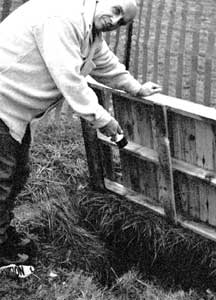                                         |
|
 |
|
Antioch
College Professor Peter Townsend showg one of the holes that has
recently appeared on the Antioch 'golf course.'
|
Caused
by collapse of cave system—
Holes
sprout on Antioch ‘golf course’
Walking across the
Antioch College “golf course” could be “extremely dangerous,”
due to a recently discovered area of Karst, or cave system, collapse,
a college professor said Tuesday.
“People need to be aware that the low area of the golf course is
too dangerous to walk on,” said Peter Townsend, professor of geology
and environmental studies. “People could disappear into the ground.”
In the past few weeks, Townsend said, he has become aware of three separate
holes, one 25 feet deep, in two areas of collapse. These areas are now
encircled by an orange fence, and the holes are covered with wood. While
people should stay away from those areas, they are less dangerous than
potential areas of collapse as yet undiscovered, he said.
Karst collapse takes place when the ground above an underground cave system
suddenly collapses, Townsend said. He believes the area beneath the golf
course was originally a cave system that glaciers filled with debris when
they covered the land tens of thousands of years ago. Trees’ root
systems probably helped maintain the ground’s stability, he believes,
but the cutting down of forests resulted in a loss of that stability.
More recently, the building of quarries in the Glen might have led to
the washing out of the caves’ sediment, which probably emptied into
the quarry and into Yellow Springs Creek.
Townsend did not speculate on a specific trigger for the Karst collapse,
though he said that enough time has passed since the quarries’ construction
for the ground to become unstable.
The first indication that an underground cave system existed beneath the
golf course came in 1975, said Townsend, when an Antioch College professor
discovered a deep hole in the area on his way to work. Over the years
the college has continually filled up the hole with gravel, said Townsend,
who began suspecting an underground cave system existed because of the
amount of gravel needed to stabilize the ground.
Several weeks ago, villager Corrine Pelzl alerted Townsend of the presence
of several unexplained holes in the golf course. A week ago, he said,
he realized the holes were quickly becoming deeper or larger.
The two areas of collapse are located on a line of low land that extends
from the end of Herman Street to Corry Street. One area contains a small
but very deep hole, about two feet by two feet wide, and about 25 feet
deep, said Townsend. The other area contains a wider hole, about three
to four feet long and two feet across, which is currently only a few feet
deep but seems to be getting deeper quickly, he said.
The collapsed areas are located north of the Antioch School parking lot.
The school has been alerted of the situation, said Townsend, although
he remains concerned that children need to understand the gravity of the
situation.
Currently, the college plans to keep all identified collapsed areas fenced,
said Townsend. He plans to study the area in a geology class he’ll
teach next semester. Townsend also said he hopes, at some point after
the collapsed areas are identified, to cover the openings with treated
wood, then introduce bat colonies to the underground caves.
—Diane Chiddister
|



